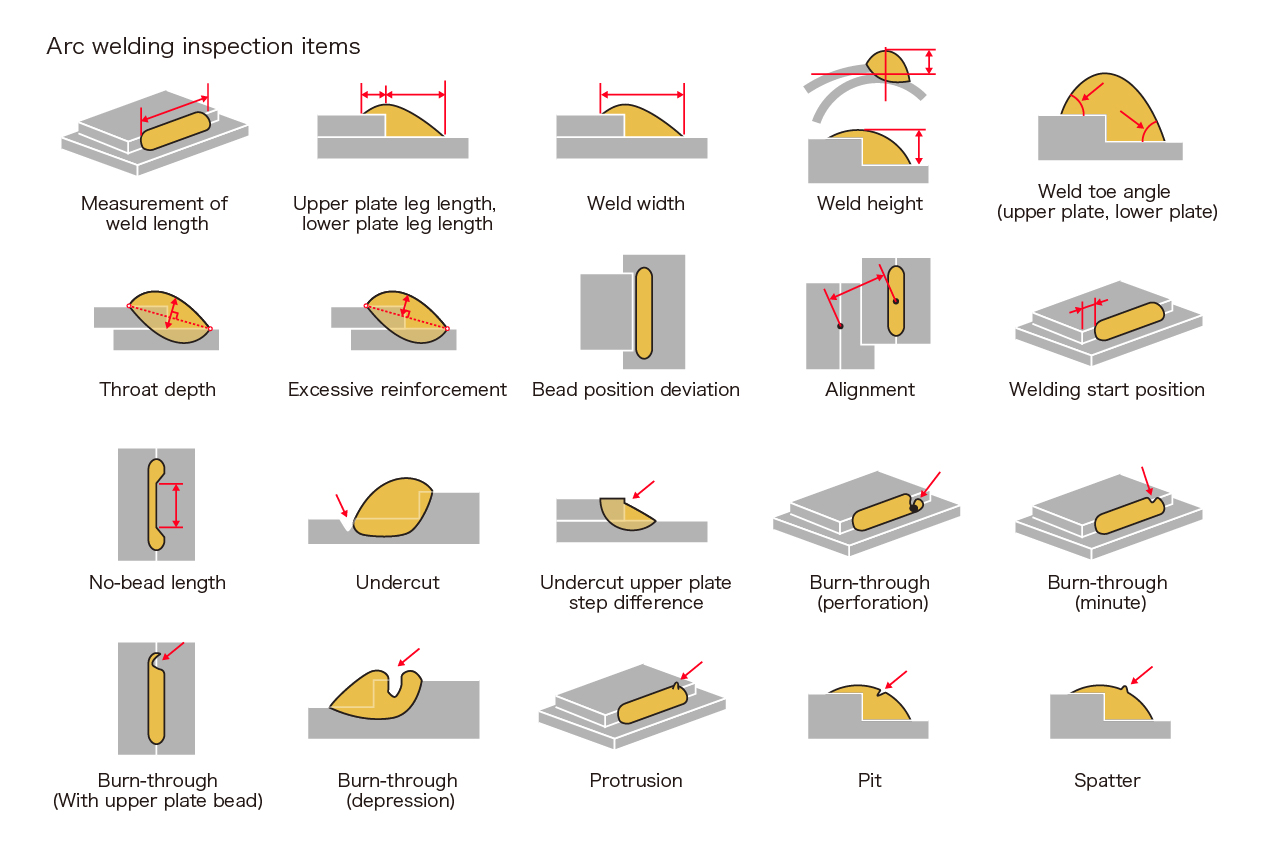The Necessary Role of Welding Evaluation: Comprehending the Procedures, Equipment, and Standards That Govern High Quality Analysis in Welding Workflow
Welding examination is a vital component of high quality guarantee in welding operations, making certain the structural honesty and safety of welded settings up. Understanding the interplay in between assessment methods and regulatory conformity raises crucial concerns concerning the challenges dealt with in keeping these important procedures.
Value of Welding Assessment
Welding inspection is essential in making sure the integrity and security of bonded structures, as it regularly works as the final checkpoint before parts are taken into service. The importance of this examination exists in its ability to determine prospective flaws that may compromise the efficiency and durability of welded joints. Given the high stakes involved, particularly in markets such as building and construction, aerospace, and automotive, detailed inspection processes are essential.
Welding flaws can develop from numerous variables, consisting of inappropriate strategies, poor tools, or improper products. Failing to detect these issues can result in devastating repercussions, including structural failures, which may result in injury, loss of life, and substantial financial liabilities. Welding inspection provides an organized strategy to review the top quality of welds, making certain conformity with market criteria and governing demands.
Furthermore, efficient welding evaluation adds to improving general productivity by minimizing rework and making sure that projects remain on schedule. By cultivating a society of quality control, companies can also enhance their track record and customer count on. Essentially, the relevance of welding inspection can not be overemphasized, as it plays an essential role in protecting both human lives and investments in framework.
Secret Evaluation Treatments
An extensive approach to assessment procedures is crucial for guaranteeing the top quality and dependability of bonded joints. Efficient examination starts with pre-weld evaluations, which include assessing welding requirements, material properties, and joint designs to identify potential difficulties. This prep work phase develops a standard for high quality assumptions.
During the welding process, in-process examinations are important. Inspectors keep an eye on parameters such as warm input, travel rate, and electrode angle to ensure compliance with well-known criteria. Aesthetic assessments are the first line of defense, making it possible for the recognition of surface area defects, such as fractures, porosity, or insufficient fusion.
Post-weld evaluations include advanced methods to assess the honesty of the joint. This may include non-destructive testing (NDT) approaches such as ultrasonic screening, radiographic testing, or magnetic particle screening. These methods offer much deeper insights into the inner structure of the weld, disclosing prospective flaws that may not be noticeable externally.
Documentation plays an integral role throughout the examination procedure. Comprehensive documents of evaluations, including searchings for and restorative actions, make sure traceability and liability, inevitably contributing to continuous enhancement in welding practices and general high quality guarantee.
Important Equipment for Examination
Efficient evaluation counts on making use of customized equipment designed to review the top quality and stability of bonded joints. Trick tools in this process include aesthetic inspection devices, such as multiplying borescopes and glasses, which allow assessors to determine surface area flaws and irregularities. Additionally, ultrasonic screening (UT) devices plays a critical function by utilizing high-frequency acoustic waves to find interior problems within redirected here welds, guaranteeing that hidden weak points are identified prior to they cause failing.
Radiographic screening (RT) is an additional vital approach, using X-rays or gamma rays to produce pictures of the welds, revealing interior flaws that might not show up with various other inspection methods - Houston Welding Inspection. Magnetic bit testing (MT) is used for ferromagnetic materials, permitting examiners to locate surface area and near-surface flaws by applying great particles and magnetic areas
Dye penetrant screening (PT) is likewise substantial, including the application of a fluorescent color to reveal visit the website surface area fractures and suspensions. Each of these methods and tools adds to an extensive inspection strategy, making sure that bonded structures satisfy the needed high quality requirements and remain secure for use in their corresponding applications.

Sector Criteria and Rules
Quality assurance in welding inspection is substantially influenced by market standards and guidelines that govern methods and ensure security. These criteria work as standards for quality, outlining the necessary protocols for examination, documentation, and testing. Secret organizations such as the American Welding Society (AWS), the American Society of Mechanical Engineers (ASME), and the International Company for Standardization (ISO) develop guidelines that welding experts need to stick to throughout the examination procedure.
Conformity with these standards is not just a matter of governing responsibility but likewise an important part of threat management in welding operations. They include different facets, consisting of product option, welding strategies, and qualifications of personnel. For instance, AWS D1.1 describes structural welding demands, while ISO 3834 specifies quality needs for welding procedures.
Additionally, industry laws determine the essential qualifications for welding examiners, necessitating qualifications that verify their knowledge. This positioning with requirements makes sure that assessments are done regularly and precisely, ultimately safeguarding the integrity of bonded frameworks. Following these sector requirements and policies is critical in promoting functional effectiveness and preserving public count on in welding practices.
Obstacles in Welding Assessment


Welding assessment encounters various obstacles that can impact the dependability and safety of welded frameworks. One considerable challenge is the intricacy of the welding refines themselves, which can vary greatly relying on materials, joint configurations, and environmental problems. This variability demands a detailed understanding of diverse evaluation strategies and their suitable applications.
Another difficulty lies in the progressing nature of welding modern technology. As new materials and approaches are introduced, inspectors have to constantly upgrade their understanding and skills to efficiently assess the quality of welds. Additionally, the physical access of weld places can prevent inspection efforts, specifically in confined or risky environments.
Additionally, human variables play a critical function in welding inspection. Houston Welding Inspection. The subjective nature of aesthetic examinations can result in inconsistencies, as various examiners may analyze the very same weld differently. This highlights the importance of standardized training and accreditation for inspectors to ensure a consistent method to high quality evaluation
Lastly, the integration of innovative modern technologies, such as automated assessments and fabricated intelligence, offers both chances and difficulties. While these innovations can boost accuracy and efficiency, they also call for substantial investment and know-how to apply effectively. Addressing these difficulties is crucial for keeping the integrity of welded frameworks.
Final Thought
Welding assessment is crucial for making certain the safety and stability of welded frameworks. Through strenuous analysis procedures, using specific devices, and adherence to acknowledged market requirements, the top quality of welding procedures can be systematically assessed. Obstacles continue the evaluation process, yet the execution of effective techniques can reduce risks connected with structural failings. Eventually, a robust this article welding examination framework not just ensures conformity with guidelines however additionally boosts total operational effectiveness and dependability.
Welding examination is an important element of high quality assurance in welding procedures, guaranteeing the architectural integrity and safety and security of welded settings up.Welding examination is crucial in making sure the integrity and safety of welded frameworks, as it regularly serves as the final checkpoint before elements are placed right into service. Welding inspection gives a methodical technique to assess the quality of welds, making sure compliance with sector requirements and regulative requirements.
Quality assurance in welding evaluation is substantially influenced by market standards and regulations that govern methods and ensure safety. Key organizations such as the American Welding Society (AWS), the American Society of Mechanical Designers (ASME), and the International Company for Standardization (ISO) develop standards that welding professionals must stick to throughout the evaluation procedure.